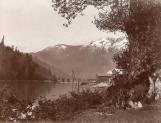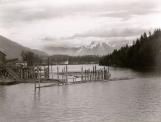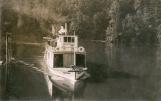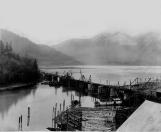1
Harrison River in Harrison Mills, BC20th Century
Kilby Historic Site, Harrison Mills, British Columbia, Canada
 Credits:
Credits:Fraser Heritage Society
2
1778- Captain James Cook travels the Pacific Ocean looking for the Northwest Passage.
1790s
- Fur traders arrive in British Columbia.
1792-1794
- Captain George Vancouver charts the area along the coast of British Columbia and Vancouver Island.
1808
- Simon Fraser and his party sweep by the mouth of the Harrison River in the final stage of their journey to the coast.
1814
- The Harrison River, called "Pinkslitsa" by the local First Nations people, appears on David Thompson's map.
1827
- Between 1827 and 1830 fur traders made attempts to investigate the Harrison waterway in search of beaver populations and transportation routes for the fur brigades. Explorations set out from Fort Kamloops in August 1827 and Fort Langley in 1828.
1828-1829
- Governor Simpson of the Hudson Bay Company officially names the Harrison River after Benjamin Harrison, a Quaker who was deputy governor of the Company from 1835 - 1839.
1847
- The Hudson Bay Company sets up a fish packing industry at the mouth of Harrison River. Though the exact location is unknown, the purpose of the site was to salt salmon for export. A number of local First Nation's people were employed there.
3
Harrison Mills on the Bank of Harrison River20th Century, Circa 1920
Kilby Historic Site, Harrison Mills, British Columbia, Canada
 Credits:
Credits:Fraser Heritage Society
4
1858- Some 30,000 miners moved into an unorganized territory that led to the creation of a new colony on the mainland, which they named British Columbia, in reference to Christopher Columbus. This ended the supremacy of the Hudson Bay Company.
- Gold was discovered in the streams and sandbars of the Fraser River. Thousands of prospectors arrived in Fort Victoria seeking passage to the mainland hoping to enter the interior and strike it rich. The most popular route was the Fraser River which led into the Harrison River and up to Harrison Lake.
- A primitive hotel stood at Harrison Mouth on the 2 1/2 acre Lot 10A during this time. Surrounded by the Scowlitz Indian reserve, it was run by a succession of hotel operators. William Ashwell also built a small store on Lot 10A.
- The Umatilla was the first steamboat to make it up the Fraser River to Yale. In a speech on July 19th, Governor Douglas states that the way to the interior is by way of the Harrison River and that a road is being prepared.
- The Umatilla stern-wheeler made a "trial" trip up Harrison River and Harrison Lake near the end of July with 80 miners onboard.
5
The "Vedder" Boat on the Harrison River beside Kilby General Store20th Century
Kilby Historic Site, Harrison Mills, British Columbia, Canada
 Credits:
Credits:Fraser Heritage Society
6
1858-1859- Harrison Mouth was a fueling stop for the paddle wheelers traveling the Fraser and Harrison Rivers.
- Governor Douglas opened the "Harrison River to Lillooet Trail" as a route to the BC interior.
- December 16th, 1859: The first record of pre-empted land in the Kent Municipality and Harrison valley was owned by John J. Ferguson and Jesse McMillan and was recorded at Port Douglas.
1859
- October 23rd: Governor Douglas named the town site at Harrison Mouth on Lot 10A "Carnarvon," after Lord Carnarvon. The town consisted of one small hotel on an Indian Reserve.
1862
- Work had begun on the Cariboo Trail route through the Fraser Canyon. Although, it was found to be a superior route, the Harrison Lake to Port Douglas-Lillooet route was still the favored trail.
- One of the Donnelly brothers recorded 160 acres of pre-empted land at Harrison Mouth. The future community of Harrison Mills developed around Lot 10A. James Donnelly, the eldest brother, managed the hotel and store and the property was in his brother Paddy's name.
1863
- Henry Bateson, a Liverpool sailor, records a piece of central land on the east bank of Bateson Slough at Lot 481 containing 160 acres in the Harrison Mills area. From this land and much of the surrounding unclaimed land, Bateson harvested and sold wild hay, shipping it by large barges called "scows" up Harrison Lake to Port Douglas where he sold it at $60 per ton.
7
Chilliwack Shingle Mill in the Village of Harrison Mills20th Century
Kilby Historic Site, Harrison Mills, British Columbia, Canada
 Credits:
Credits:Fraser Heritage Society
8
1867- Louis Nunn Agassiz pre-empted 1600 acres of land that now bears his name a few miles east of Harrison Mouth.
1873
- Harrison Mouth, later renamed Harrison Mills, operated as a refueling point for paddle wheelers.
1877
- The British Columbia Guide listed 16 people as residents of Harrison Mouth.
1884
- The first post office was established at Harrison River (Harrison Mouth).
1885
- The Canadian Pacific Railway (CPR) line was opened and was completed through Harrison Mills to Port Moody. The station at Harrison Mills was the junction for the town of Chilliwack directly across the Fraser River. The railway that linked the Canadian nation from east to west was meant to secure the territory from the Americans.
- The St. Alice Hotel was built at Harrison Hot Springs.
9
Lumber Mill in the Village of Harrison Mills20th Century, Circa 1920
Kilby Historic Site, Harrison Mills, British Columbia, Canada
 Credits:
Credits:Fraser Heritage Society
10
1886- Harrison Hot Springs Hotel neared opening, and the area was being considered for its recreational potential.
1887
- Regular train service began on the CPR.
- The first mail contract between Harrison River and Chilliwack landing was given to J.T. Harrison.
-Joseph Martin and his son Fred pre-empted the land immediately south of the CPR tracks at Harrison Mills and built the Harrison Sawmill Co. This steam powered sawmill operated until 1898.
11
Canadian Pacific Railway Bridge Construction31 December 1913
Kilby Historic Site, Harrison Mills, British Columbia, Canada
 Credits:
Credits:Fraser Heritage Society
The Foundation Company Ltd
12
Row Houses in Harrison Mills Behind Canadian Pacific Railway Bridge20th Century, Circa
Kilby Historic Site, Harrison Mills, British Columbia, Canada
 Credits:
Credits:Fraser Heritage Society
13
1888- Thomas Kilby arrived in New Westminster (Sapperton) from Ontario.
1889
- The BC Directory listed Joseph Martin as "Mill Owner, Harrison River".
- Thomas Kilby married Eliza Ann Tompkin (nee Finlay), a widow, on September 13th.
- J. Baker was recorded as the postmaster of Harrison River.
- William and Emma Menton arrived in the Agassiz area and learned of a promising business opportunity at Harrison River.
1890
- Records show that William Menton was the postmaster at Harrison River in May of this year.
- A mining boom reopened interest in the Harrison to Port Douglas-Lillooet route to the Fire Lakes Mines.
- Acton Kilby was born on August 4th, at New Westminster (Sapperton).
1891
- Emma Menton became the legal owner of Lot 10A in Harrison Mills in February of this year.
- The Hotel-Store was built in Harrison Mills and Emma Menton ran both.
- The BC Directory listed the Harrison Saw Mill Co. under Joseph Martin and Son.
1892
- The Martin's made the decision to move their milling operation to the other side of the Harrison River to a site beside the new railway and to build a large new mill. The new mill site was a half-mile away from Lot 10A toward the west. This was a steam-powered mill. The whole community moved westward with it over the next few years.
1894
- William Menton captained a series of boats that plied the trade on Harrison River. The first was "Gypsy" a 50ft. screw tug. Next was the "Willie," and later the "Welcome."
- Harrison River District on the left bank of the Harrison became incorporated as Ward 1 of the Municipality of Kent on September 27th, 1894.
- Activity increased at the site of Lot 10A in Harrison Mills with the CPR station of Cheam becoming the junction for the large agricultural center of Chilliwack. It was the commercial center of the district for the next decade.
14
Chilliwack Shingle Mill in the Village of Harrison Mills20th Century
Kilby Historic Site, Harrison Mills, British Columbia, Canada
 Credits:
Credits:Fraser Heritage Society